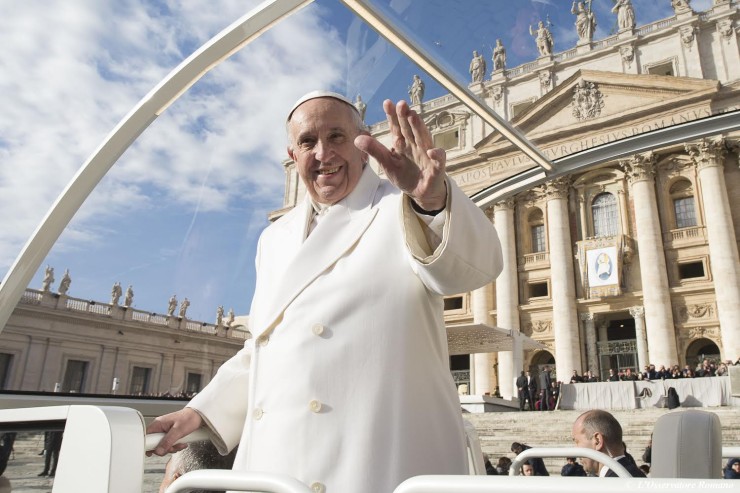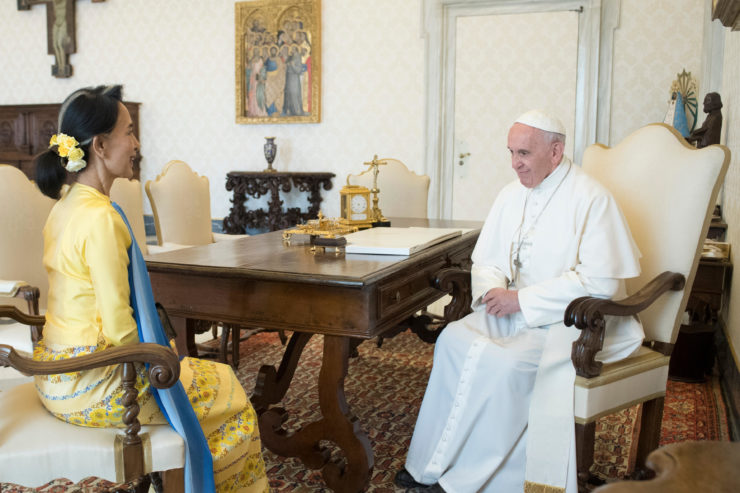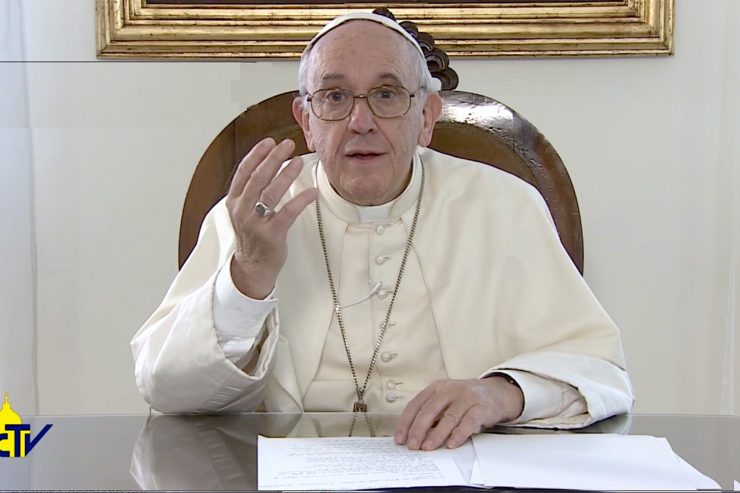“We must not hesitate to make ourselves first of all disciples and then supporters of the school of prayer, which is about to begin,” Pope Francis quoted blessed Pope Paul VI on the occasion of the Italian Liturgical Week.
Pope Francis received in audience, August 24, 2017, at 12:00, in Paul VI Hall (Vatican City), the participants in the 68th National Italian Liturgical Week. This year’s theme is “A Living Liturgy for a Living Church,” on the occasion of the 70
th anniversary of the founding of the Italian
Center of Liturgical Action.
“Vatican Council II matured, as good fruit of the tree of the Church. The Constitution on the sacred liturgy
Sacosantum Concilium (SC), whose lines of general reform responded to the real needs and the concrete hope of a renewal: a living liturgy was desired for a Church altogether enlivened by the mysteries celebrated,’ said Pope Francis.
And the Pope underlined the “vitality” of the Church in prayer: “It was about expressing in a renewed way, the perennial vitality of the Church at prayer, being eager so that the faithful do not assist as strangers and silent spectators to this mystery of faith, but, understanding well through rites and prayers, participate in the sacred action knowingly, piously, actively” (
SC , 48)”.
He also quoted Paul VI’s speech during a General Audience in 1965: “This was recalled by Blessed Paul VI in explaining the first steps of the announced reform:’It’s good to warn how it is proper for the authority of the Church to desire, to promote, to arouse this new way of praying, thus giving greater increment to her spiritual mission [. . .]; and we must not hesitate to make ourselves first of all disciples and then supporters of the school of prayer, which is about to begin.'”
“We can affirm with certainty and with magisterial authority that the liturgical reform is irreversible,” said Pope Francis.
The Holy Spirit, said the Pope, creates a “harmony” although there are different Catholic rites: “The harmony of the ritual traditions of the East and West, by the breath of the same Spirit gives voice to the one praying Church for Christ, with Christ and in Christ, to the glory of the Father and for the salvation of the world.”
Here is ZENIT’s full translation of the Pope Francis’ address, in Italian, to those present at the meeting.
AB
* * *
The Holy Father’s Address
Dear Brothers and Sisters, good morning!
I welcome you all and I thank the President, His Excellency Monsignor Claudio Maniago, for the words with which he presented this National Liturgical Week, at 70 years from the birth of the Center of Liturgical Action.
This span of time is a period in which, in the history of the Church and, in particular, in the history of the liturgy, essential and not superficial events have happened. As Vatican Council II will not be able to be forgotten, so will the liturgical reform be remembered from which it issued.
The Council and the reform are two directly linked events, which did not flower suddenly but were prepared for long. It is attested by what was called the liturgical movement, and the answers given by the Supreme Pontiffs to the hardships perceived in ecclesial prayer. When a need is noticed, even if the solution isn’t immediate, there is the need to start to move.
I think of Pius X, who ordered a reordering of sacred music
[1] and the celebratory restoration of Sunday,
[2] and instituted a Commission for the general reform of the liturgy, knowing that it would entail a work both great and short-lived; and therefore – as he himself recognized – it was necessary for many years to pass, before this, so to speak, liturgical
edifice [. . .] reappeared shining in its dignity and harmony, once it had been cleansed from the squalor of ageing.”
[3]
Pius XII took up the reforming project with the Encyclical
Mediator Dei[4] and the institution of a Study Commission
;[5] he also took concrete decisions regarding the version of the Psalter,
[6] the attenuation of Eucharistic fasting, the use of a living language in the Ritual, the important reform of the Easter Vigil and of Holy Week.
[7] From this impulse, on the example of other Nations, the Center of Liturgical Action arose in Italy, led by Bishops solicitous of the people entrusted to them and animated by scholars that loved the Church as well as the liturgical pastoral.
Vatican Council II then matured, as good fruit of the tree of the Church, the Constitution on the sacred liturgy
Sacosantum Concilium (SC), whose lines of general reform responded to the real needs and the concrete hope of a renewal: a living liturgy was desired for a Church altogether vivified by the mysteries celebrated. It was about expressing in a renewed way, the perennial vitality of the Church at prayer, being eager “so that the faithful do not assist as strangers and silent spectators to this mystery of faith, but, understanding well through rites and prayers, participate in the sacred action knowingly, piously, actively” (
SC , 48). This was recalled by Blessed Paul VI in explaining the first steps of the announced reform: “It’s good to warn how it is proper for the authority of the Church to desire, to promote, to arouse this new way of praying, thus giving greater increment to her spiritual mission [. . .]; and we must not hesitate to make ourselves first of all disciples and then supporters of the school of prayer, which is about to begin.”
[8]
The direction traced by the Council found form, according to the principle of respect of the healthy tradition and of legitimate progress (Cf.
SC, 23),
[9] in the liturgical books promulgated by Blessed Paul VI, well received by the Bishops themselves who were present at the Council, and by now for almost 50 years universally in use in the Roman Rite. The practical application, guided by the Episcopal Conferences, for the respective countries, still prevail, because it’s not enough to reform the liturgical books to renew the mentality. The reformed books, following the norm of the decrees of Vatican II, have implanted a process that requires time, faithful reception, practical obedience, wise celebratory implementation on the part, first of all, of ordained ministers, but also of the other ministers, the cantors, and all those that take part in the liturgy. In truth, we know it, the liturgical education of Pastors and faithful is a challenge to address always again. Paul VI himself, a year before his death, said to the Cardinals gathered in Consistory: “The moment has now come, to let the tendencies to division fall, equally pernicious in one way and another, and to implement integrally in their just inspiring criteria, the reform approved by Us, in the implementation of the Council’s votes.”
[10]
And there is still work to do today in this direction, in particular, rediscovering the reasons for the decisions taken with the liturgical reform, surmounting unfounded and superficial readings, partial reception and practices that disfigure it. It’s not about rethinking the reform by looking again at the choices, but of knowing better the underlying reasons, also through historical documentation, as well as to internalize the inspirational principles and observing the discipline that regulate it. After this magisterium, after this long journey we can affirm with certainty and with magisterial authority that the liturgical reform is irreversible.
The task to promote and guard the liturgy is entrusted by law to the Apostolic See and to the diocesan Bishops, whose responsibility and authority count much at the present moment; also involved are the national and diocesan organisms of the liturgical pastoral, the Institutes of formation and the Seminaries. Distinguished in this formative realm in Italy is the Center of Liturgical Action with its initiatives, among which is the annual Liturgical Week.
After having reviewed this journey with the memory, I would now like to touch upon some aspects in the light of the theme on which you have reflected these days, namely: “A Living Liturgy for a Living Church”
The liturgy is “living” because of the living presence of Him who “dying has destroyed death and rising has restored life to us again” (Easter Preface I), Without the real presence of the mystery of Christ, there is no liturgical vitality. As without a beating heart there is no human life, so without the beating heart of Christ here is no liturgical action. What defines the liturgy is in fact the implementation, in the holy signs, of the priesthood of Jesus Christ, that is, the offering of His life to the point of extending His arms on the cross, priesthood rendered present constantly through the rites and the prayers, maximally in His Body and Blood, but also in the person of the priest, in the proclamation of the Word of God, in the assembly gathered in prayer in His name (Cf.
SC , 7). Among the visible signs of the invisible Mystery is the altar, sign of Christ living stone, discarded by men but becoming the corner stone of the spiritual edifice in which worship is offered to the living God in spirit and in truth (Cf. 1
Pt 2:4;
Eph 2:20). Therefore the altar, center toward which our attention converges in our churches,
[11] is dedicated, anointed with chrism, incensed, kissed, venerated: the gaze of the praying people, priest and faithful, is oriented to the altar, convoked for the holy assembly around it;
[12] placed on the altar is the offering of the Church that the Spirit consecrates Sacrament of Christ’s sacrifice; given from the altar are the bread of life and the chalice of salvation “so that we become in Christ one body and one spirit” (Eucharistic Prayer III).
The liturgy is life for the entire people of the Church.
[13]By its nature the liturgy is in fact “popular” and not clerical, being – as the etymology shows – an action
for the people, but also
of the people. As so many liturgical prayers recall, it is the action that God Himself carries out in favor of His people, but also the action of the people that listen to God who speaks, and they reacts praising Him, invoking Him, receiving the inexhaustible source of life and of mercy that flows from the holy signs. The Church at prayer gathers all those who have a heart listening to the Gospel, without discarding any one: convoked are the little and the great, the rich and the poor, children and elderly, the healthy and the sick, the righteous and sinners. In the image of the “immense multitude” that celebrates the liturgy in the shrine of Heaven (Cf.
Revelation 7:9), the liturgical assembly surpasses, in Christ, every limit of age, race, language and nation. The “popular” scope of the liturgy reminds us that it is inclusive and not exclusive, advocate of communion with all without, however, homologizing, because it calls each one, with his vocation and originality, to contribute in building the Body of Christ: “The Eucharist is not a Sacrament “for me,” it is the Sacrament of many that form one body, the holy faithful people of God.”
[14] We must not forget, therefore, that it is first of all the liturgy that expresses the
pietas of all the people of God, prolonged then by pious exercises and devotions that we know with the name of popular piety, to be appreciated and encouraged in harmony with the liturgy.
[15] The liturgy is life and not an idea to understand. In fact it leads to living an initiating experience, which is transformative in the way of thinking and behaving, and not to enrich one’s baggage of ideas on God. Liturgical worship “is not first of all a doctrine to understand or a rite to carry out; it is, of course, also this but in another way, it is essentially different: it is a source of life and of light for our journey of faith.”
[16]
Spiritual reflections are something different from the liturgy, which “is in fact to enter in the mystery of God; to let oneself be led to the mystery and to be in the mystery.”
[17] There is a good difference between saying that God exists and feeling that God loves us, as we are, now and here. In liturgical prayer we experience communion signified not by an abstract thought but by an action that has for agents God and us, Christ and the Church.
[18] The rites and the prayers (cf.
SC , 48) for what they are and not for the explanations we give them, become therefore a school of Christian life, open to all who have open ears, eyes and heart to learn the vocation and the mission of Jesus’ disciples. That is in line with the mystagogic catechesis practiced by the Fathers, taken up also in the
VCatechism of the Catholic Church, which treats of the liturgy, of the Eucharist and of the other Sacraments in the light of the texts and rites of today’s liturgical books.
The Church is truly alive if, forming one living being with Christ, she is bearer of life, is maternal, is missionary, goes out to encounter the neighbor, solicitous of serving without chasing after worldly powers that render her sterile. Therefore, celebrating the holy mysteries recalls Mary, the Virgin of the
Magnificat, contemplating in her “as in a most pure image, what the whole of her desires and hopes to be” (
SC, 103).
Finally, we canot forget that the richness of the Church at prayer in as much as “catholic” goes beyond the Roman Rite that, although being the most extensive, is not the only one. The harmony of the ritual traditions of the East and West, by the breath of the same Spirit gives voice to the one praying Church for Christ, with Christ and in Christ, to the glory of the Father and for the salvation of the world.
Dear brothers and sisters, I thank you for your visit and I encourage those in charge of the Center of Liturgical Action to continue having faith in the original inspiration, that of serving the prayer of the holy people of God. In fact, the Center of Liturgical Action has always been distinguished for the care it gives to the liturgical pastoral, in fidelity to the indications of the Apostolic See as well as of the Bishops and enjoying their support. The long experience of the Liturgical Weeks, held in numerous dioceses of Italy, together with the “Liturgy” review, has helped to
the liturgical renewal in the life of the parishes, of seminaries and of religious communities. Toil has not been lacking, nor has joy! It is again this commitment that I ask of you today: to help the ordained minsters, as well as the other ministers, the cantors, the artists, the musicians to cooperate so that the liturgy is “source and summit of the vitality of the Church” (Cf. SC, 10). I ask you, please, to pray for me and I impart to you from my heart the Apostolic Blessing.




